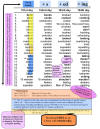Sequential Spelling is a uniquely constructed spelling system with the following key features in its methodology:
- Words are taught in relationship to one another, both horizontally and vertically
- Children can figure out spelling rules for themselves from their relationships and commonalities, but they are only taught at the teacher's discretion
- Students begin by "testing" themselves by trying to write words correctly before they study them
- Words for each grade level are selected for common elements rather than grade level appropriateness
As these features might seem odd, we'll try to explain them. (And you can certainly go the publisher website for more information.)
How Does This Work?
Sequential Spelling teaches word relationships in a unique way, by working with words both horizontally and vertically. Lessons build from common elements in two directions. For example, the first common element in level 1 is "in." Three different beginnings are added to "in" to create "pin," "sin," and "spin." That is the vertical development.
On the second day, horizontal development is added by expanding the first day's words to "pins," "sins," and "spins," etc. Although the first lesson is short, by the ninth day, there are 25 words per day.
| 1st Day |
2nd Day |
3rd Day |
4th Day |
Features |
|
in
pin
sin
spin
|
I
pins
sins
spins
kin
skin
win
twin
|
thin
pinned
sinned
I
shin
skins
wins
twins
be
begin
chin
she |
thins
pinning
sinning
spinning
shins
skinned
winning
inner
be
begins
chins
we
wee
bee
see
tree |

(click to enlarge)
|
Although the words are related by phonograms or common elements, it is left to the students to make their own connections and formulate rules inductively (kids who hate learning rules will appreciate this, but those who want explanations for why things work they way they do will not like it as much). Parents may certainly add rules if they wish, but it is not a part of the basic lessons of Sequential Spelling. The publisher is clear that rules are referenced—they're just listed in their book Patterns of English Spelling (which retails for more than $300, but is available for free if you become an AVKO member).
Students begin by "testing" themselves, but this is not a pretest; rather, actual instruction. The parent/teacher says a word, uses it in a sentence, and then repeats the word. (Sentences are available in the publisher's Word Families in Context, but we found this awkward to use during a lesson.) Children write the word the best they can, even if they only know a few letters that might be in the word. After they take their best guess, the teacher writes the word for them. Before going on to the next word, the students correct their word as needed. The idea is that they process their mistakes and make the necessary correction. Thus they think about the construction of words in a different way than they do using most other curricula. This will be helpful for some children and frustrating for others.
As they continue to build horizontally and vertically, students are quickly spelling words that would be considered well beyond their grade level. For example, by the fifth day, they are spelling "beginning." And by the last lesson of level 1, there are no easy words: among the 15 words are "spying," "multiplying," "dissatisfying," "falsifying," "denying," "lullabies," "couldn't," "wouldn't" and "schools." (Try that list with most fifth graders!)
Recently this course has undergone a few minor alterations. The teacher's guides for grades 1-4 have been revised—basically the same as before, the course notes for teachers at the beginning have been streamlined, and answers to all exercises in the student workbook are now included in the back. The student workbook is itself an innovation, and while it eliminates the need for lined sheets of paper, it does little else; beside a few word finds and fill-in-the-blanks, the workbook is simply lists of blank lines on which to write spelling words.
Instructional DVDs are also available for the first three levels, with a level four DVD due out soon. These eliminate the need for a teacher as students simply watch each lesson and complete the work themselves, but since the course is pretty easy to teach already and not very time consuming for parents, the price of the DVDs will render them superfluous for many families.
Our Honest Opinion:
Overall, we are impressed by how comprehensive this program is, even without the extra materials the publisher recommends. It includes homophones, homographs, heteronyms, prefixes/roots/suffixes, and what the author calls "advanced pattern" words such as "techniques," "chauvinism," and even "hors d'oeuvres!" We are also happy to hear the positive comments from customers: most have been very pleased with their students' progress, including those who are prone to dyslexia. (For those families, we recommend the AVKO membership; they really have a lot to offer.)
Sequential Spelling has seven levels intended to be used sequentially. You can start them as early as second grade, but we'd recommend starting and using a little bit later. If you are wanting to use it for an older, remedial student, we'd recommend replacing Book 1 with If It Is to Be, It is Up to Me to Do It, a book that uses the same model, but provides more help for a tutor (like example sentences that won't turn off an adult). Students can write their word lists in their own notebook, or in the AVKO Student Response Book, the only consumable element to the program.
 |
Review by C. Hollis Crossman
C. Hollis Crossman used to be a child. Now he is a husband and father, teaches adult Sunday school in his Presbyterian congregation, and likes weird stuff. He might be a mythical creature, but he's definitely not a centaur.Read more of his reviews here.
|
Did you find this review helpful?